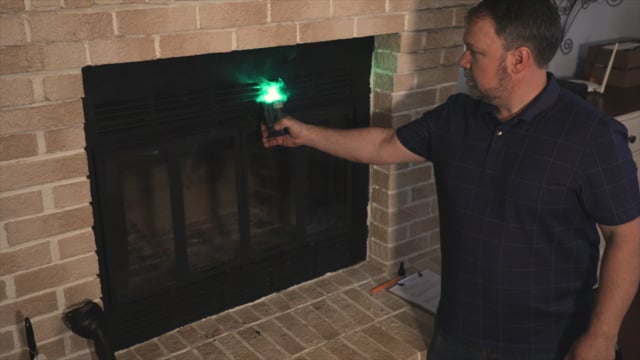
by blogediter | Sep 6, 2023 | Chimney Problems
How to use a Smoke Pencil in a fireplace to test for smoke draft, air leakage, or downdraft.
Fireplaces are designed to move air. The Dept of Energy estimates the fireplace makes up 14% of a homes air leakage. But many times we do not want our fireplace to do move air. We just want our fireplace to sit there in the corner and look pretty, and not let in outside air that is too hot or too cold, or suck out our inside air that we paid dearly for our HVAC to condition. But despite your best efforts of air sealing and troubleshooting, you still get drafts or smells coming from the fireplace.
Using a Smoke Pencil in a fireplace is the right tool to visualize the air currents
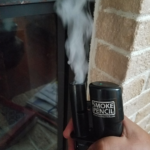
Smoke Pencil in a Fireplace
Air infiltration can come from an number of locations in a fireplace, Here are a few: the chimney, the brick connections, the fresh air intake, the ash chute, outside ash dump door, the glass door, the heat exchanger, etc…So even if you have a Chimney Balloon or a Flueblocker installed in your fireplace, you may still have air movement in your firebox that needs to be addressed.
It can be tricky to know whether the air is coming from up the flue or from the walls or the floor of the firebox. So the Smoke Pencil in a fireplace allows you to make puffs of vapor or trailing lines of vapor so you can pinpoint where the air is coming from.
Here is a list of some of the areas to check in your fireplace for air infiltration:
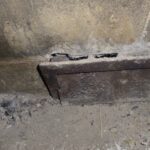
Ash chute door
- Ash Chute Dump: On the floor of your fireplace there can be a small trap door or a grate that leads to a hollowed out chute below. This is an ash chute. It is a cleanout for the firebox so you don’t have to scoop out the ashes after a fire. But it is always best to scoop out the ashes from the firebox, so you can get them out of the house. Ashes left in the chute can retain a burnt smell and that will come up from the chute and stink up the house.
- Ash Chute Dump Cleanout Door: If you have an ash chute, there there will be a cleanout door or port either on the outside wall of your fireplace, or in your basement or crawlspace. These doors are notoriously leaky and provide a perfect location for air to get sucked into the firebox.
- Fresh air intake: There is sometimes a fresh air intake on the side of the firebox wall. It directly lets in outside air for the fire. But it is also very drafty when not in use. Sometimes in factory built or prefabricated zero clearance fireplaces, you wont even see them because they are hidden behind the fire brick layer. But if air is getting sucked through the wall of the firebox, you will know that you have a fresh air intake.
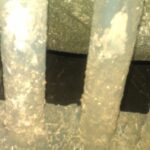
fireplace heat exchanger
- Heat exchanger: Many hearth constructions have grates that look like they serve no purpose, but they are part of a rudimentary heat exchanger. The thought is, if they leave open pockets around the firebox then those pockets will collect warm air during a fire. That air will circulate and come out into the room. Some even have fans attached to force the air around. But those air pockets can also let in outside air.
- Glass Doors: It may seem counterintuitive but glass doors can let in outside air in prefabricated fireplace. The glass door tracks are built into the metal box that also has the damper and chimney and attach the firebox walls. Those metal attachments can leak air, and it shows up through air infiltration the glass door tracks.
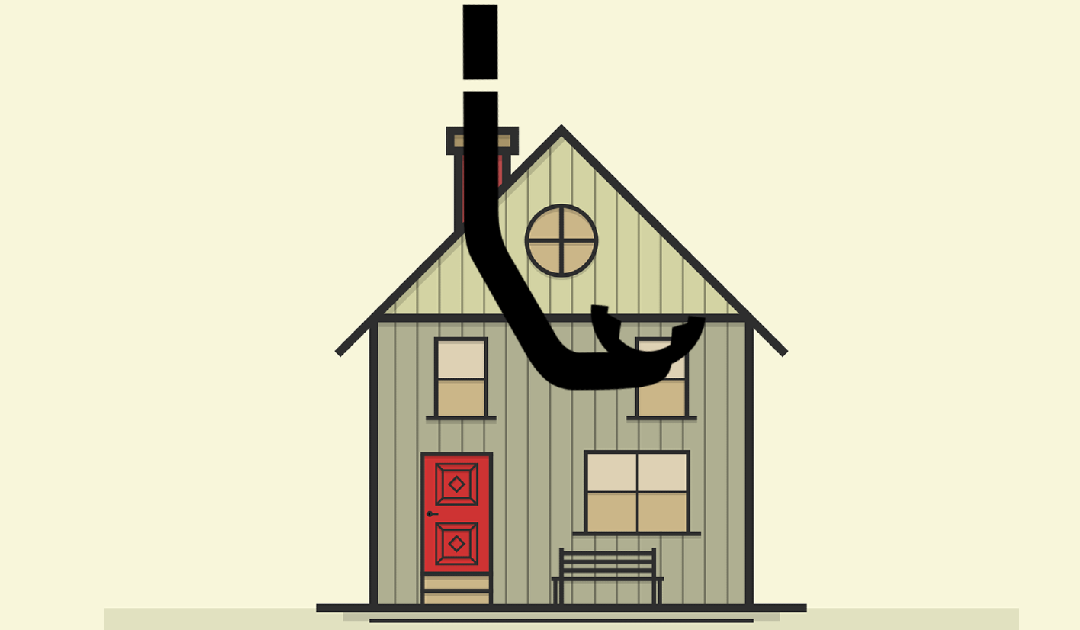
by blogediter | Jul 31, 2023 | Chimney Problems
Do you have a room in your house that has a fireplace, and is really hard to cool in the summer? Your fireplace chimney snorkels in hot, humid, dirty air from your roof all summer.
Metal dampers are just rough-closures and have no weatherstripping to them, so they let a lot of air past. So when you close up your house and turn on the AC for the summer, your home will often operate at a negative pressure and start drawing in outside air from the path of least resistance. It is really important to air seal a fireplace since it accounts for 13% of air leakage to an average home.
Below is a video of a Smoke Pencil demonstrating how much outside air a fireplace chimney snorkels in with a closed damper and a closed glass doors.
Your fireplace chimney snorkels in hot humid air from your roof. You may not feel the heat draft coming in, but often you can smell a musty smokey smell that is present in the house as your fireplace chimney snorkels in chimney stink with the warm air.
It is important to plug a fireplace or wood stove chimney with a Chimney Balloon or Flueblocker in the summer to prevent chimney snorkeling like this. A tight fitting chimney plug will force the home to draw make-up air from another location, other than the dirty snorkel that is your chimney.
Have you ever gone snorkeling at the beach and set your mask and snorkel kit in the sand for a moment?
The sand, grime, salt water, and beachy smell get all over it. Now imagine grabbing that snorkel kit, not wiping it off, and popping it right into your mouth and taking a big inhale…* cough*cough*. That is the equivalent of what a fireplace chimney snorkels into your home all summer long. Only your home is breathing in hot, humid, ash and creosote tinged, dirty air. And in turn you and your family are breathing it in too.
You can avoid all of that heat, humidity and chimney stink from closing your flue low and tight with a Chimney Balloon or a Flueblocker from our online fireplace store.
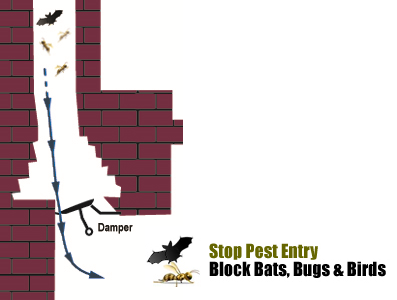
by blogediter | Jun 19, 2023 | Chimney Problems
How to stop bats and birds from entering your fireplace chimney
Have you ever spent your evening with all the doors and windows open as you try to coax a bat or bird out of your house? Then you know bats and birds are common pests that can find their way into your home through the fireplace chimney. Birds and bats eat mosquitos and are great to see flitting around your yard, but they are lousy house guests. So lets see how do I keep bats from coming down my chimney?
Bats can carry diseases, so there are dangers of bats in chimney, and you can’t safely smoke out bats in chimney. You may be wondering how to tell if bats in chimney. Bats in chimney sound like a quiet squeaky bike wheel, and they make a scuffling and scratchy noise as they climb. Bat removal from chimney cost stat at $120 for the service call and it usually cost another $100 for the relocation of the animal. So it is best to keep them from entering and claiming your chimney for their home.
Birds can make a mess and damage your chimney and home. Birds can make obnoxious noise and bring in flammable nesting material that plugs the chimney. Also their droppings smell very bad.
You cannot burn or smoke out birds either. But, if you have bats and birds in your chimney, there are a few things you can do to get rid of them and prevent them from coming back.
Listed below are 4 steps to stop bats and birds from entering your fireplace chimney:
1. Seal up any entry points. The first step is to seal up any entry points that bats or birds could use to get into your chimney. This includes any cracks or holes in the seam between where the brick chimney meets the homes wood or vinyl exterior. Inspect the crown and the flashing of the chimney and see if there are cracks they are getting through.
2. Install a chimney cap with a screen. Some chimneys have not cap at all, some have a cover with no screen, some have a screen with no cap. The best cap is one that is galvanized or stainless steel, and has a cover and a screen. A cap like this will last a long time, and prevents bats and birds from getting in, while still allowing smoke to escape. You can get a cheaper powder coated or painted sheet steel chimney cap, but they rust our fast and won’t last long.
3. Use a Flueblocker of Chimney Balloon. If you don’t want to mess with a cap at the roof, Don’t rely on just your metal damper to keep out bats or birds. They can get through a metal damper without even slowing down. Metal dampers are loose and warped, so a bird or bat can slip right past a damper. You will need a tight seal from a Chimney Balloon or wool Flueblocker to stop a bat or bird.
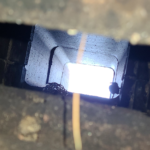
Bird in fireplace chimney flue
4. Call a professional. If you have a serious problem with bats or birds getting in repeatedly or nesting in your home, you may need to call a professional. A wildlife removal company will be able to safely and humanely remove the pests from your home, and troubleshoot the areas that may be letting them in. Sometimes the chimney is not the only location they gain entry.
Getting help stop bats and birds from entering your fireplace chimney
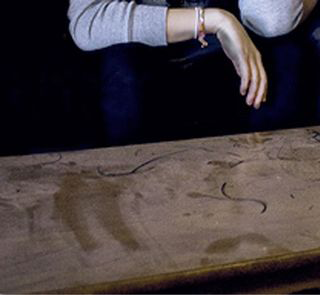
by blogediter | Jun 12, 2023 | Chimney Problems
Air sealing and air filter tips that can make your home a safe haven from wildfire smoke and dust
You can see on the wildfire smoke map more and more of the United States experience smoke from this season’s wildfires, it is important to air seal and air filter your home for fending off smoke and particulates. You can make your home a safe haven from wildfire smoke, so you can get away from the fine particulates from wildfires like PM2.5, that cause the greatest health concern.
Here are the 5 air sealing and air filter tips that can make your home a safe haven from wildfire smoke and dust. So you can see how to protect yourself from wildfire smoke:
1) Air sealing your home is essential. Modern homes operate under pressure. Sometimes homes are inhaling air from outside, and sometimes they are expelling air. HVAC, venting, clothes dryers, and all kinds of appliances affect how your home takes in outside air. Use a
Smoke Pencil to hunt around your house to see where your home is intaking air, and use weatherstipping, caulk, and foam to seal out air infiltration. If you notice a heavier than normal dust coating on your furniture, you can bet that the particulate count is up inside your home.
2) Focus on the biggest holes first. One of the worst culprits in letting in outside air is the dormant fireplace chimney. It acts like a snorkel sticking up into the smokey sky. Whenever you use an appliance that vents to the outside (like a clothes dryer), the negative pressure will pull outside air through the path of least resistance. That is often the chimney, even if it has a damper the metal is usually ill fitting and warped, allowing a gush of air to pass through. So use a tight fitting
Flueblocker or
Chimney Balloon to close the chimney off.
3) Air Filters are key: Eventually you need to open your doors to come in and out, so there is bound to be smoke that gets inside. It is hard to find the best
HEPA indoor air filters in stock at the moment, but there are
DIY home air filters that can be made with
furnace filters and a box fan that are very effective. Also have a close look at your HVAC filters in your A/C system. Do not use the cheap stringy fiberglass filters, rather make sure you have fine filters with a MERV rating of 13 or higher.
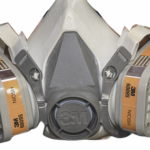
Protect against smoke with Respirator Mask
4) Mask shields up: When you do go out, it is best to have a P95 respirator mask with activated carbon. That way you are protected from particulates and chemicals that ride the smoke. They are only about $20 and they are well worth the price. You can even get some variety that cover your eyes as well.
5) Don’t make your indoor air quality worse: Avoid using your gas burning range while you are buttoned up avoiding wildfire smoke. Try heating food just with the microwave for a while. Limit using ventilation appliances like clothes dryers and vent fans. They create negative pressure in your home and force the house to take in more outside air. It may sound extreme, but hang a clothesline inside to dry your clothes.
It is also important to keep track of the public announcements of when you must evacuate an area due to poor air quality or even fire danger. Do not put you or your family and loved ones at risk. There are wildfire smoke health effects long-term and short-term.
In order to make your home a safe haven from wildfire smoke and dust, you should follow the steps above and contact us if you need help selecting products to air sealing your fireplace and home.
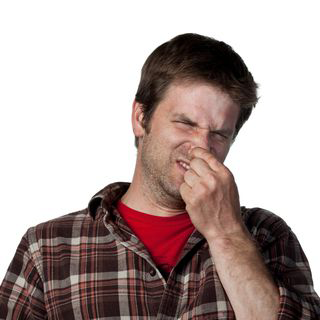
by blogediter | Jun 7, 2023 | Chimney Problems
Fix bad burnt smelly fireplace odors and foul smokey chimney ash stink
So you had a fire or two over the winter months, and even as it sits dormant your unused chimney smells bad. You made sure to clean out the old ash and leftover charred logs from your firebox, but the chimney smells when it rains. You even took out the vacuum hose and really cleaned out the firebox super well. But you are still trying to fix bad burnt smelly fireplace odors and the house smells like smoke from fireplace.
Most of the time, home owners go right to scheduling with their chimney sweep to stop the smell. But a chimney scrubbing can sometimes make the burnt smokey smell worse. Here are a few DIY cheap things to try first to help you stop the smokey chimney stink:
Here are the 3 steps to fix bad burnt smelly fireplace odors and foul smokey chimney ash stink:
1)
Seal the chimney low and tight. Your chimney operates like a dirty snorkel for your house. It breathes in and it breathes out. Even if your metal damper is closed, they do not seal tightly. Metal dampers warp when they are heated and cooled repeatedly. Also, the negative pressure in your house from clothes dryers, HVAC, vent fans, etc.. can suck outside air right down the flue and drag in chimney smells. By installing a
Flueblocker or
Chimney Balloon as low as possible in the flue, you can seal much of the smell outside.
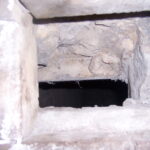
Ash pit causes smokey smell
2) Look for an ash pit. Look at the floor of your firebox. Is there a metal flapper there or an open hole that leads down into an ash dump pit? You may have to pry up and remove the flapper cover of the ash pit to get access to the hole itself. That chute will need to be sealed up tightly too. You can inflate a small Chimney Balloon into the pit to seal it off tightly.
3)
Baking Soda to deodorize the firebox. The firebox may be clean and vacuumed out, but the creosote glaze or leftover ash could still be releasing acrid acidic odors. This is how to make fireplace smell good and how to get rid of soot smell in house. Take a full box of
baking soda and sprinkle it over the floor of the firebox, and throw it against the walls of the firebox.
You can use a little spray bottle of water to damper the walls to get the powdery baking soda to stick, but don’t go too crazy with the sprayer. Let that sit in the firebox for a few weeks, and use a vacuum hose with a VERY good filter to vacuum that up.
99% of the time these 3 tips work and eliminate the odor issue, but If you still need to fix bad burnt smelly fireplace odors and foul smokey chimney ash stink contact us for personalized troubleshooting over the phone. You may have some chimney or home related issues to take into consideration.
There are a million variables, and we can help you get to the bottom of it, so you can close the burnt fireplace smell out of your home.
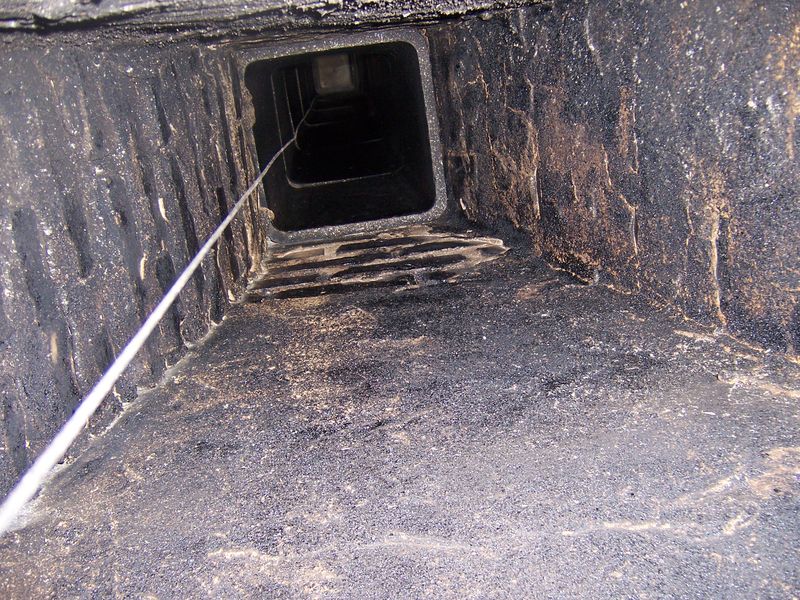
by blogediter | Jul 10, 2019 | Chimney Problems
Q: Jason, I have a top style damper with a wire that comes down into the fireplace to pull tight. When I install a chimney pillow, should I open the top damper? I know doing this will allow the pillow to seal better at the location where the wire comes down, but I don’t know if it is ok to leave the top damper open. I have a terrible smell that I am trying to seal off and hope the pillow will help solve this. Also, I have an ash pit opening on the bottom of the fireplace – should I seal this with a pillow as well? – MF
Q: Hi MF,
HI Mike,
Your application is exactly like an application I walked through for a customer in Rockford, IL and we got it resolved quite easily. I attached some pictures of the Rockford install for your reference.
The trouble you are running into is the top damper is bottling up the chimney at the top, so when the cold air conducts through the chimney bricks the cooler creosote-laced air in the chimney has no place to go but come down into the house. Often the negative pressure in the house that the HVAC introduces, coupled with the open portal between floors through the ash cleanout, will amplify the smell problem.
So here is how we fix it…. Install a Chimney Balloon just above your old low metal damper frame (top left photo). For now, install it with the Chimney Balloon top damper open so the cable is slack. This will allow your chimney to vent the smell out the top, but not let the smell in the house. For the ash cleanout, take the cover off the chute for the cleanout and measure the hole going down (bottom left photo). Most of the time it will be smaller than a 9×9, so you can just install a 9×9 upside down into that chute. This effectively stops the air exchange through the Chimney Balloon and the ash cleanout. After a few months, you can close the top damper after it has time to air out.
One side note though. Make sure your Chimney Balloon top has a built-in screen over it to keep squirrels and birds out? – Jason











